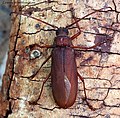| Bandar pascoei | |
|---|---|
 | |
| Scientific classification | |
| Domain: | Eukaryota |
| Kingdom: | Animalia |
| Phylum: | Arthropoda |
| Class: | Insecta |
| Order: | Coleoptera |
| Suborder: | Polyphaga |
| Infraorder: | Cucujiformia |
| Family: | Cerambycidae |
| Genus: | Bandar |
| Species: | B. pascoei |
| Binomial name | |
| Bandar pascoei (Lansberge, 1884) | |
| Synonyms | |
| |
Bandar pascoei is a species of longhorn beetle native to Asia with a wide range of distribution. [1] [2] The species is a delicacy in Thailand. [3]
The species can be found from India and Sri Lanka, through China and Indo-China to Borneo and Java [4] [5]
The host plants of the larva include: Castanea mollissima , Diospyros kaki , Malus pumila , Pistacia chinensis , Prunus armeniaca , Prunus persica , Pyrus serotina and Quercus variabilis . [4]
- from Thailand
- from Thailand
- from Thailand
- from Malaysia
- Head profile
- Elytra expanded
- subspecies formosae






